- Expert advice/
- Invites & paper/
- Invitations/
- What's Included In a Wedding Invitation Suite?
- Invitations
What's Included In a Wedding Invitation Suite?
Wondering how to convey all the information needed for your wedding in a stylish and elegant way? The wedding invitation suite is the perfect option.
Last updated February 5, 2024

The First Look ✨
- Your wedding invitation suite is a set of matching cards with all the necessary information that guests should know about your big day.
- Some of the most common enclosure cards found in wedding invitation suites are: reception card, attire card, transportation information, directions insert, wedding itinerary, response/RSVP card, wedding website card, and accommodations card.
- There are certain pieces of information that must be included: The location, date, and time of the ceremony and reception, and the RSVP information.
- Putting together a stunning invitation suite is easy at Zola. Our selection of gorgeous invitations and enclosure cards can be customized to fit the style of your suite.
Wedding invitations are the beautiful pieces of paper that you get in the mail when a loved one is getting married. This essential stationery is typically pretty straightforward—it tells you the date, time, and location of the ceremony. But, most weddings have a lot more going on than just the ceremony itself.
From the reception dinner to the farewell brunch, a wedding weekend is often packed with activities in various places. So, how does one convey all this extra information in an equally stylish and elegant way? With a wedding invitation suite, of course.
In this article, we’ll be discussing the ins and outs of putting together the perfect wedding invitation suite.
What Is a Wedding Invitation Suite?
Getting down to the specifics—a wedding invitation suite is essentially a set of matching enclosure cards with extra decor. Enclosure cards contain additional information that doesn’t fit on your invitations alone.
Since most couples prefer to keep their invitations neat and simple, at least one enclosure card is almost always included inside the main envelope. A smaller envelope inside will separate the two cards, and the invitation is typically in front. While a basic enclosure card may list vital details about the reception, a wedding invitation suite is designed to go above and beyond the basics and truly prepare guests for the events to come.
What Does a Wedding Invitation Suite Look Like?
Your wedding invitation suite will look more like a package, rather than a small envelope. This is because most invitation suites are made up of several matching cards, various envelopes, and any other decorative elements that you choose to include.
Your invitation suite is also a chance to get creative. Couples can make a variety of decisions when putting this together, such as:
- Choosing a color scheme
- Adding ribbons
- Including colorful envelopes
- Using a wax seal
- Incorporating lace details
These are just a few of the things that make invitation suites so much fun. If you’re a couple who takes pride in the stylistic elements of your big day, then putting together a wedding invitation suite may be the way to go.
Finding the perfect stationery for your invitation suite is easy when you use Zola. Couples can choose from hundreds of stylish wedding invitations, along with matching enclosure cards to fit all the necessary information.
What’s Included in a Wedding Invitation Suite?
It’s important to note that every couple’s invitation suite may look a little different. Not only does personal style have an effect on the invitation suite, but the events related to your actual wedding will determine what’s included, too.
That being said, there are a few key elements that most people traditionally include in their wedding invitation suite. Let’s take a look at the basic enclosure cards you can choose from (along with a few unique options that might pique your interest).
#1 Direction Card
A direction card—or direction insert—is another popular addition to wedding invitation suites. While many people may scoff at the idea of physical directions (given the blessing of modern GPS technology) there are several reasons why a direction insert can still be helpful for guests:
-
Rural weddings – For ceremonies taking place off the beaten path, physical directions can be extremely useful in helping guests arrive on time. From lost cell service to unmarked roads, you never know what a rural, beachside, or mountain top wedding venue may throw at you.
-
Traffic – If you’re planning a wedding in a more urban location, directions can be just as practical—but for slightly different reasons. Couples can list alternative routes, rush hour times, and streets to avoid in order to help their guests beat the local traffic and get to the ceremony like a true local.
-
Different directions – Some guests may be coming from all over the place, particularly if you have multiple neighboring cities. In this case, it may be courteous to write out separate directions for guests depending on which neck of the woods they’re coming from.
Combining written directions with a visual map will make your directions insert easier to understand, especially when guests are on the move.
#2 Reception Card
A reception card is one of the most important elements found in a wedding invitation suite. Why is that?
Many couples opt for a separate location to host their reception in. This is particularly common for ceremonies that take place at religious or outdoor spaces, with little-to-no accommodations for the dinner, dancing, and other festivities that take place during the reception.
Your main wedding invitation will typically list the time and location of the ceremony, with no information regarding the reception, other than maybe a line that says “reception to follow.” So, what do you do if there’s another location that guests need to know about? Include a reception card.
Your reception card should have the following information listed on the front, in simple, straightforward language:
- The date of the reception
- The time the reception starts
- The time when dinner will be served (if applicable)
- The location of the reception venue
- What will be occurring at the reception (dinner, drinks, appetizers, dancing, etc.)
If you’re looking for a venue that can host both your ceremony and reception, try utilizing Zola’s list of pre-screened wedding vendors. Our venue list can be narrowed down using a filter for ceremonies, receptions, or both.
#3 Transportation Card
Similar to the reception card, couples who have booked multiple venues for their wedding will need to keep guests informed on transportation details. To put it simply, you probably don’t want guests transporting themselves from the ceremony to the reception if you can avoid it. By keeping everyone together, you’ll ensure a more seamless transition from one portion of the night to the other.
Furthermore, guests may also need help getting from the reception venue to their hotel accommodations—especially if they’ve had one too many champagne toasts during dinner. For all these reasons, we recommend including a transportation card in your wedding invitation suite. Whether you’re providing limo services, a shuttle, or ride-sharing options—the details and timeline of any and all transportation should be listed on this card.
#4 Attire Card
It never hurts for guests to be on the same page about the dress code—which is why some couples choose to add an attire card to their wedding invitation suite.
An attire card is going to help friends and family avoid any wardrobe embarrassment. While many weddings encourage formal attire, figuring out the exact level of formality isn’t always easy when you’re a guest. Your attire information may be added to another enclosure card, or included on its own as a small business card. On it you’ll specify which of the following dress codes are required for the ceremony and reception:
-
Black tie – Formal gowns and tuxedos are typically expected for a black-tie wedding.
-
Cocktail – Cocktail attire signifies that dresses may be shorter in length, while still maintaining a fairly formal look overall.
-
Semi-formal – A semi-formal dress code typically includes long, but simple dresses paired with suits (but not tuxedos).
-
Casual – Casual wedding attire is often welcome for outdoor ceremonies, particularly those near the beach. For a semi-formal dress code, guests may opt for lightweight maxi dresses, button-up shirts, and slacks.
#5 Response/RSVP Card
One of the most important parts of your wedding invitation suite will be the response card. On the response card, your guests will fill out the main sections:
- Whether they will or will not be attending the wedding
- Which entree choice they would prefer for the rehearsal dinner
Some couples may also include a line for plus ones or children who will be accompanying the invited guest, but this part is optional.
Incorporating a response card in your invitation suite is vital because it allows guests to RSVP for the event. Without RSVPs, couples may be ill-prepared for the amount of guests who are actually attending the wedding.
That being said, while RSVPs are important, physical response cards are quickly becoming an outdated practice. Rather than relying on postage to slowly build a final wedding guest list, many couples opt for a digital guest manager—like Zola’s online RSVP tracker—instead. With an online RSVP, you can add names to your guest list as soon as they respond, rather than waiting for physical cards to arrive in the mail. This also makes the organization process much easier, since you won’t be dealing with dozens (or even hundreds) of paper response cards.
#6 Wedding Website Card
Another small (but important) element of your invitation suite is your wedding website card. If you’ve put the time and effort into crafting a beautiful wedding website, you’ll want to make sure that guests know how to access it. This is especially important for websites that are locked with a password.
Simply add your URL and any passwords necessary to a small business card, and include this among the other stationery in your invitation suite. This is a great place to put additional information that won’t fit in the envelope, such as your wedding registry details.
#7 Accommodation Card
It’s crucial that out-of-town and destination wedding guests have all the information they need for their accommodations. Whether you’re paying for a hotel room, blocking out rooms for guests to book, or simply recommending nearby facilities—this is something you’ll want to include along with your invitation. Accommodations can play an influential role in your guests’ ability to attend the wedding, so try to be as detailed and specific here as possible.
Information regarding accommodations can also be listed on your wedding website. Clickable links may make booking a room easier on guests, especially if you’ve booked up a hotel block in your name. Make sure to give guests all the information needed in order to utilize the room block—since many hotels will require a name and password to reserve these rooms.
#8 Itinerary Card
Whether you’re hosting a destination wedding or a ceremony in your hometown, most couples tend to throw a few additional events during their nuptial weekend. For this reason, you may want to incorporate an itinerary card in your invitation suite. An itinerary card will help encourage guests to attend all the festivities surrounding the big day.
Examples of items that may be listed on an itinerary card include:
- The rehearsal dinner
- The welcome celebration for out-of-town guests
- The ceremony
- The cocktail hour
- The reception
- The farewell lunch, brunch, or dinner
Times, dates, and locations should all be listed for each event on your wedding itinerary. Consider this card an invitation for the entire weekend, and format it similarly to your main wedding invitation.
Designing Your Wedding Invitation Suite
Now that we’ve covered the basics, we can get to the fun part of invitation suites: designing them. After all, nobody creates a wedding invitation suite if they’re not interested in adding a little flair.
Putting together the wedding invitation suite is one of the most creative parts of wedding planning. Couples can take this opportunity to incorporate their own unique wedding style into the decor of the invitation suite. While your decorative options are practically unlimited, some of the most common ways couples personalize their invitation suite include:
Matching It to Their Wedding Color Palette
If you’ve chosen a color palette for your wedding decor, then this is the perfect way to tie your invitation suite into the big day. By sticking with the same color palette and design elements, you’ll be able to give guests a sneak peek of what’s to come on the wedding day. Below are some of the ways color can be incorporated into your invitation suite:
- The outer or inner envelope
- The stamp
- The ribbon
- A wax seal
- Any dried flowers or botanical elements
Other Decorative Elements
If you’re looking to play with more than just color, there are a few other ways that couples can personalize their wedding invitation suite. Try out these fun, stylish ideas for wedding invitations that truly stand out from the crowd:
-
Return envelope and postage – If you’ve included a physical response card in your invitation suite, it’s important to insert a return envelope and postage, too. Not only will this make the process easier for your guests, but it's also another opportunity to get creative with your design. Embossed lettering, interesting paper, and stylish font for the return address are a few ways to customize your envelopes. Some couples take this a step further and order custom stamps with their names, their photo, or simply some cute wedding art.
-
A custom photo – If you’ve had any engagement or wedding portraits taken recently, now is the perfect time to show them off. Couples can either add a photo as the backdrop for one of their enclosure cards, or simply include a separate photo as an additional element to the package.
-
Belly band – A belly band is another popular element that couples tend to include in their wedding invitation suites. Instead of a simple ribbon tying the cards together, a belly band is a thicker strip of fabric that keeps everything in line. A belly band will typically be adorned with small artwork or the initials of the marrying couple. Lace, wax, or parchment paper may be incorporated into a belly band design, too.
-
Foil – Metallic foil is a simple way to boost the elegance of your wedding invitation suite. Gold, silver, or rose gold outlines add just the right amount of shimmer to typography and borders. Foil is also a wonderful way to match your invitations to the cutlery, jewelry, and centerpieces that you’ve chosen for the reception.
When Should I Send Out My Wedding Invitation Suite?
Another important piece of information you’ll need when crafting your invitation suite is a proper timeline. Similar to individual invitations, you’ll want to send out your wedding invitation suite around six to eight weeks before the wedding date.
This will give guests plenty of time to send in their response cards and make travel arrangements. Six to eight weeks is also enough time for the couple to finalize a guest list based on RSVPs, as well as put together their seating chart.
As for destination weddings, you may want to send out your invitation suite a bit earlier. Invitation etiquette for destination weddings states that suites should be sent out approximately 12 weeks before the wedding date. Most couples planning destination weddings tend to keep their guest list small, therefore their loved ones are most likely aware of the plan before the invitations are even sent out.
We recommend ordering your wedding invitations and enclosure cards well in advance, in order to avoid any delays or shipping issues. Six months before the wedding is typically the ideal time to place your order for any stationary included in the invitation suite.
Craft Your Dream Invitation Suite at Zola
No matter what nuptial necessity you’re in the market for, Zola is here to help. We’re a one-stop shop for all things wedding—from eye-catching wedding invitations to matching enclosure cards, and even stunning save-the-dates with customizable features.
The perks of using Zola don’t stop at the stationary, either. Couples can also utilize our pre-screened wedding vendors to find wedding venues, DJs, caterers, and more. Additionally, we also offer Expert Wedding Advice to help you plan your perfect day every step of the way.
Putting together a wedding takes work, but it doesn’t have to be stressful. Shorten your to-do list and start planning your big day the modern way at Zola.
Up next for you
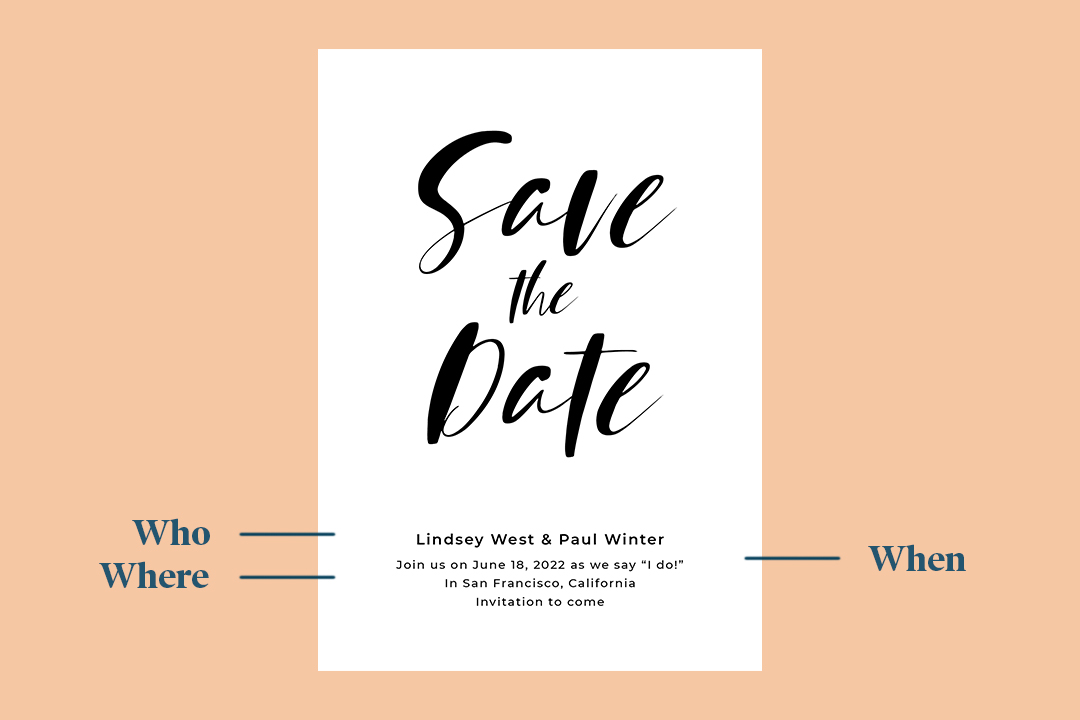
A Guide to Save The Dates
Inspiration
Save the dates add an extra touch of style and coordination to your wedding. Find out why and when you should send your save the dates with this complete guide.
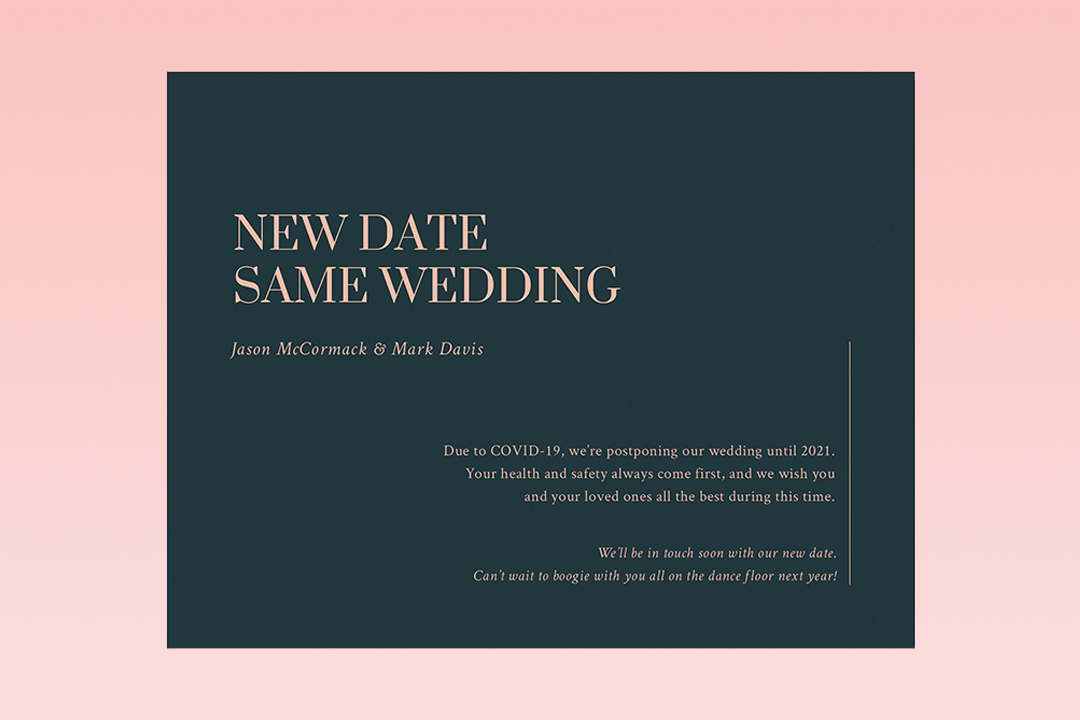
How to Update Guests About Changes to Your Wedding
How-To
If you need to postpone, cancel, or otherwise change your wedding details, we're here to help with our guide to updating your wedding guests about changes.
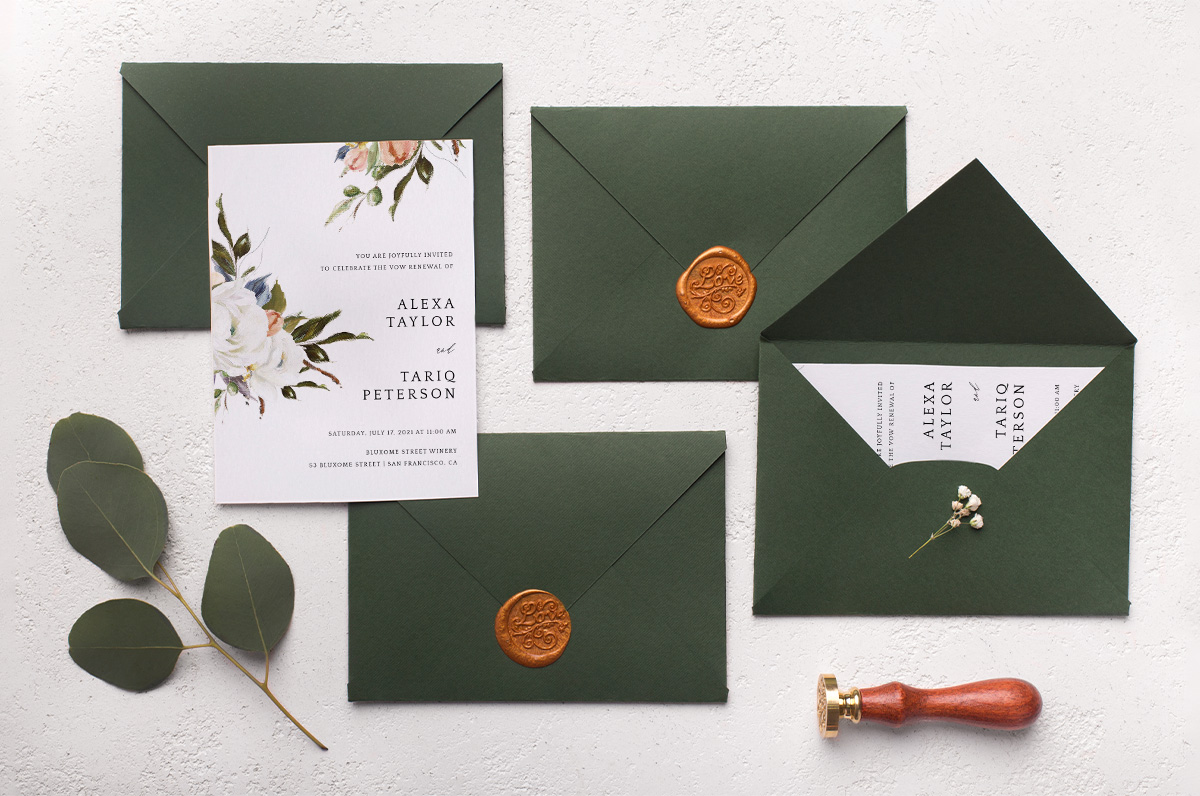
Guide to Wedding Invitation Wording
How-To
Your invitations set a first impression. In this guide, our experts lay out everything you need to know about wedding invitation wording and etiquette.

When To Send Save The Dates
Advice
Timing is key! Generally, save the dates should be sent no earlier than 8 months and no later than 4 months out from your wedding. Learn the specifics and more in this article.
Featured
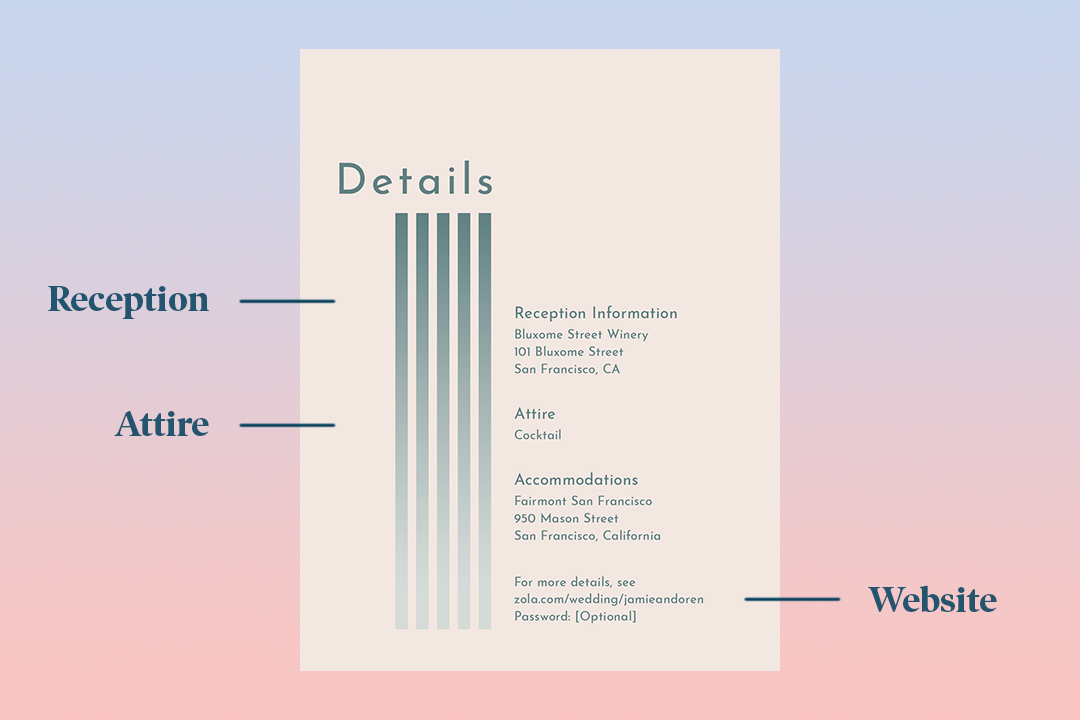
A Guide to Enclosure Cards
How To
Starting to create enclosure cards for your wedding? Follow along as we break down everything you need to know.
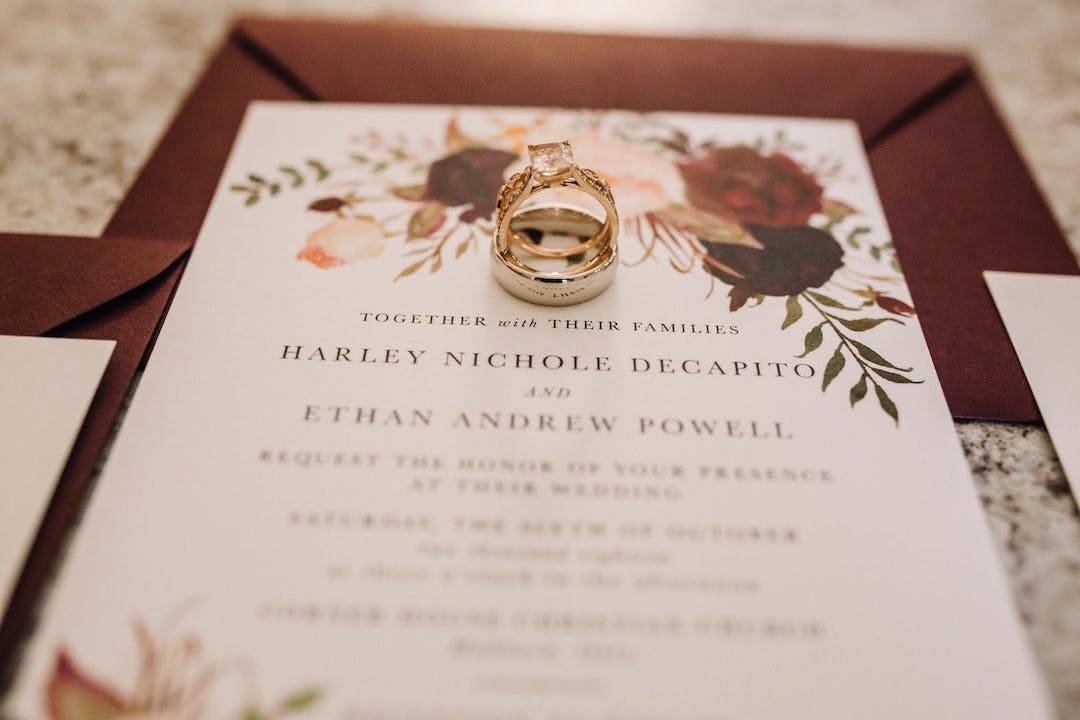
12 Rustic Wedding Invitations Ideas to Inspire You
Inspiration
Rustic weddings make the natural feel new again. Whether you’re opting for hand-drawn florals or festival prints, here are some ideas for rustic wedding invitations.

21 Unique Wedding Invitation Ideas
List
We have scoured the web for the most unique wedding invitations on the stationery scene, and we’re sharing them here.

Wedding Invitation RSVP Cards: Wording & Etiquette
Inspiration
Master wedding RSVP card wording and etiquette. Craft the perfect invitations with our guide, ensuring a smooth and organized guest response.
- Expert advice/
- Invites & paper/
- Invitations/
- What's Included In a Wedding Invitation Suite?
Find even more wedding ideas, inspo, tips, and tricks
We’ve got wedding planning advice on everything from save the dates to wedding cakes.
